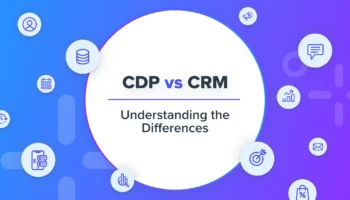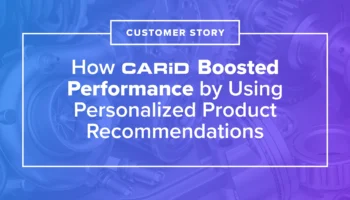If you’re looking for Klaviyo alternatives because you feel like you’ve hit a ceiling with what it can offer, you’re not alone.
Klaviyo has established itself as a robust email marketing platform, offering features like advanced segmentation, automation workflows, and seamless e-commerce integrations. These capabilities have made it a popular choice for many businesses aiming to enhance their email marketing strategies.
But for many teams, especially as they grow, the marketing stack starts to feel more like a tangled web than a streamlined system. In fact, 64% of marketers say their martech stack has become more complex in recent years, adding friction to already fragmented workflows
While Klaviyo does a lot of things well, it wasn’t built to be your long-term solution for orchestrating complex, cross-channel journeys powered by live data.
If you’re reading this, you’ve probably already made up your mind, or you’re close. You know that your marketing has outgrown batch-based tools and rigid workflows. You’re looking for a platform that evolves with your business, not one that holds you back.
In this blog, we’ll walk you through why Blueshift is a leading Klaviyo alternative for modern marketers seeking smarter, more scalable engagement.
TL;DR
If Klaviyo is starting to feel limiting, you’re not alone. As brands expand, many outgrow batch-based tools and seek more flexibility, intelligence, and scale. Blueshift is built for that next stage of growth.
- Integrated CDP: Unifies customer data in real time for a single customer view across channels.
- AI-Powered Personalization: Delivers predictive recommendations, real-time dynamic content, and automated optimization.
- Enterprise Scalability: Handles large catalogs, high-volume traffic, and complex workflows without friction.
- Smarter Pricing: Pay only for active contacts—no need to purge your list to control costs.
- Simplified Migration: Blueshift’s team supports data migration, integrations, and onboarding for a smooth transition.
What Are the Limitations of Klaviyo and Why Do Marketers Look for Alternatives?
Klaviyo offers features like campaign automation, segmentation, and e-commerce integrations, which have helped many businesses take their first steps toward sophisticated email marketing.
But as businesses grow in complexity, they launch more channels, serve more customer segments, and require real-time intelligence.
At this point, marketers often cobble together multiple tools to fill the gaps, which fragments workflows, silos data, and creates inconsistent customer experiences. And that’s exactly when many teams start looking for alternatives.
Blueshift vs. Klaviyo: Key Differences That Matter
Wouldn’t it be awesome if your marketing platform could actually keep up with your growth?
If you’re comparing Klaviyo alternatives, it’s important to look beyond surface-level features and consider how each platform fits into your broader marketing strategy.
That is where Blueshift shines. It integrates a powerful CDP, AI-first architecture, and scalable personalization tools—all built for brands that are ready to elevate their strategy and deliver real-time, one-to-one engagement across channels.
1. How Blueshift’s Integrated CDP Outperforms Klaviyo’s Data Capabilities
Blueshift’s standout feature is its built-in Customer Data Platform (CDP). Unlike Klaviyo, which offers more limited customer data management, Blueshift’s integrated CDP creates comprehensive customer profiles by:
- Unifying data from multiple sources and touchpoints
- Creating a single customer view across devices and channels
- Enabling real-time identity resolution that connects anonymous visitors to known customers
- Supporting deterministic cross-channel identity matching techniques
This unified approach eliminates data silos and provides a 360-degree view of each customer, enabling more precise targeting and personalization.
2. Why Blueshift Delivers Smarter Personalization Than Klaviyo
Blueshift’s AI-powered personalization engine delivers truly individualized content:
- Predictive recommendations based on browsing history, purchase patterns, and affinity modeling
- Dynamic content blocks that adapt in real-time based on user context
- Behavioral triggers that respond to specific user actions
- Self-optimizing campaigns that automatically select the best content for each recipient
While Klaviyo offers basic personalization, Blueshift’s advanced AI allows for much more sophisticated approaches to delivering the perfect message to each user.
3. How Blueshift Handles Large Product Catalogs Better Than Klaviyo
Blueshift excels at managing large product and content catalogs, making it ideal for businesses with extensive offerings:
- Dynamic catalog management that handles millions of SKUs effortlessly
- Advanced product recommendation algorithms that consider real-time behavior
- Ability to personalize based on catalog attributes, user preferences, and engagement history
- Support for diverse content types, including products, articles, videos, and more
Compared to Klaviyo’s more limited catalog capabilities, Blueshift allows marketers to leverage their entire inventory for highly relevant recommendations. These advantages make Blueshift a compelling Klaviyo alternative for retail and content-rich businesses.
4. How Blueshift’s Architecture Supports Real-Time, Enterprise-Scale Marketing
Blueshift utilizes a modern event-driven microservices architecture that provides:
- Greater scalability to handle traffic spikes without performance degradation
- Improved reliability with redundant systems and failover capabilities
- Faster processing of real-time data for immediate campaign activation
- Independent scaling of different system components based on demand
This contrasts with Klaviyo’s more monolithic architecture, which can experience bottlenecks during high-volume periods.
5. Why Blueshift’s AI Infrastructure Powers More Intelligent Campaigns
Blueshift’s architecture was designed from the ground up with AI capabilities in mind:
- Native machine learning models integrated into the core platform
- Distributed computing resources dedicated to predictive analytics
- Automatic model training and optimization without manual intervention
- Custom algorithm development capabilities for unique business needs
Unlike Klaviyo’s more limited predictive capabilities, Blueshift’s AI infrastructure allows for sophisticated customer journey orchestration without requiring data science expertise.

6. Why Blueshift Is the More Scalable Klaviyo Alternative for Pricing
Blueshift’s pricing structure offers significant advantages:
- Based on monthly active known email addresses rather than total list size
- Allows you to maintain more extensive databases without paying for inactive contacts
- Eliminates the need to purge your list to control costs regularly.
With Klaviyo’s increasing prices, it’s becoming harder for marketers to justify the cost-benefit tradeoff.
How to Switch from Klaviyo to Blueshift Without Disrupting Your Marketing
Evaluating Klaviyo alternatives can feel overwhelming, but making the switch doesn’t have to be. If Blueshift aligns with your needs, the migration process is simple and supported every step of the way.
It involves just a few key steps:
- Data migration, including subscriber lists, segments, and historical engagement metrics
- Template conversion and campaign setup
- Integration with your existing tech stack
- Team training on the new platform
Migrating to a Klaviyo alternative doesn’t have to be complicated, especially when the alternative is designed to scale with your business. Blueshift offers dedicated migration specialists to ensure a smooth transition with minimal disruption to your ongoing marketing activities.
Is Blueshift the Klaviyo Alternative Your Business Needs to Scale?
According to recent survey data, 86% of marketing leaders now prioritize Customer Engagement Platforms (CEPs) over point solutions. This change reflects how marketers are moving away from fragmented ESPs in favor of unified, cross-channel platforms.
For a deeper dive into why marketers are moving beyond traditional ESPs, check out this blog on why marketers need a Customer Engagement Platform.
If you’ve outgrown Klaviyo, it might be time to upgrade to a platform built for modern marketing.
With Blueshift, you gain real-time customer intelligence, hyper-personalized experiences, and smarter campaign performance.
Request a personalized demo to see how Blueshift delivers the scale, intelligence, and flexibility modern marketers nee




